
Shenyang is a sub-provincial city in China and the provincial capital of Liaoning province. It is the province's most populous city with a population of 9,070,093 as of the 2020 census, also making it the largest city in Northeast China by urban population, and the second-largest by metropolitan population. The Shenyang metropolitan area is one of the major megalopolises in China, with a population of over 23 million. The city's administrative region includes the ten metropolitan districts, the county-level city of Xinmin, and the counties of Kangping and Faku.

Doncaster Corporation Tramways was an electric tramway network serving the town of Doncaster, England. It was authorised in 1899, and the first route to Bentley opened in 1902. This remained separated from the rest of the system until North Bridge was built to carry traffic over the Great Northern Railway main line to Edinburgh. Soon afterwards, deep mining of coal began in the area, and several extensions to the system were made between 1913 and 1916 to serve new communities which developed around the pit heads. The Racecourse route was unusual, in that it had balloon loops at both ends to enable almost continuous running on race days, a feature that was not common in England, and only found favour in Europe in the 1950s and 1960s.
Trams in Asia were well established at the start of the 20th century, but started to decline in use in the 1930s. By the 1960s, the majority of systems had been closed down. Extensive legacy tramways still exist in Japan. Recently, more modern systems have been built in China.

The Shenyang Metro is a rapid transit system part of the urban rail transit system of Shenyang, Liaoning, China. It currently covers 9 of the 10 municipal districts in Shenyang City. Shenyang is the seventh city in Mainland China with an underground subway. In history, Shenyang's earliest written subway planning can be traced back to 1940 during the Manchurian period. After the founding of the People's Republic of China, due to some reasons, Shenyang Metro has been set up many times, and the construction has been suspended several times. The construction of the Shenyang Metro, which is currently in operation, began in 2005 and has been in operation since September 27, 2010. As of January 2025, Shenyang Metro has a total of 6 operating lines with a total length of 186.7 kilometers and 136 operating stations. In 2020, the annual passenger traffic was 310 million, with an average daily passenger flow of 849,000. Shenyang Metro is operated and built by Shenyang Metro Group Co., Ltd.
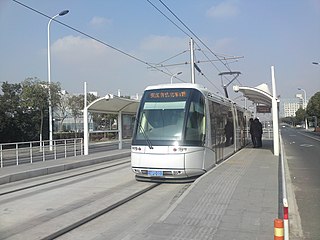
Zhangjiang Tram was a tram network operating in Shanghai that utilised a Translohr system. Shanghai originally had a steel wheeled electric tramway network in its urban center. Routes expanded gradually and reached largest extent in 1925 with 328 tramcars; this tram system shut down in 1975. Tram service returned to Shanghai with the opening of a rubber tired Translohr line in the suburban Zhangjiang Hi-Tech Park in 2010. It is the second rubber-tired tram system in both China and Asia, the first being TEDA tram in Tianjin.
Gyaincain Norbu is a Tibetan politician in the People's Republic of China. He was chairman of the Tibet Autonomous Region from 1990 to 1998. He was succeeded by Legqog.

The Shenhe District is one of ten districts of Shenyang, the capital of Liaoning province and the largest urban center in Northeast China. Shenhe District is where Shenyang's old city resided, currently serves as the one of the two central districts of Shenyang and hosts the seat of the City Government. It borders the Dadong District to the northeast, Hunnan District to the south, Heping District to the west, and Huanggu District to the northwest.
First generation trams in Shanghai began operating in 1908 using a steel wheeled electric system until the last was closed in December 1, 1975. The last operating tram line in Shanghai was No. 3, which ran from Hongkou Park to Jiangwan Wujiaochang. It was dismantled in 1975, and replaced by the 93 bus. In the early days of operation, tram cars were partitioned to provide first- and second-class seating. Some trams, principally for the Chinese workers, were designated as third-class.
Southend-on-Sea Corporation Transport was the overarching name given to the local municipal transport services provided to the town of Southend-on-Sea by the local council. Initially started as a tramway, although known officially as Southend-on-Sea Corporation Light Railway, the trams started operating on 19 July 1901 until the service was terminated on 8 April 1942. A trolleybus system was introduced in 16 October 1925, gradually replacing the tramway, before it closed on 28 October 1954. Motorbuses were first run by the Corporation in 1914, but two years later they withdrew the services. Buses did not return to the Corporation's service until 1932, eventually replacing the trams and trolleybuses. In 1974, the organisation was renamed Southend Transport, and after the Transport Act of 1985, it became involved in a bus war with rival Thamesway. The council sold Southend Transport to British Bus group in June 1993, which in turn was taken over by the Cowie group. Cowie was renamed Arriva in August 1998, with Southend Transport becoming Arriva serving Southend.
Aberdare Urban District Council Tramways operated a tramway service in Aberdare between 1913 and 1935. It was the only system in the United Kingdom which consisted of a tramway with feeder services run by trolleybuses from the start. The trolleybuses used the Austrian Cedes-Stoll system, and became increasingly difficult to maintain. Parts of the trolleybus network were converted to tramways in the early 1920s, and the rest stopped operating in 1925, when no trolleybuses were available for service. The tramway continued for another ten years, but was closed in 1934 and 1935 as a result of a downturn in the prosperity of Aberdare, due to collieries closing and the population dwindling. Motor buses took over the local services once the tramway had closed.
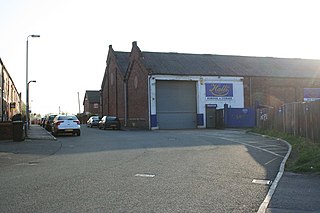
Wigan Corporation Tramways operated a tramway service in Wigan, England, between 1901 and 1931. The first tramway service in the town was run by the Wigan Tramways Company, whose horse trams began carrying passengers in 1880. They began replacing horses with steam tram locomotives from 1882, but the company failed in 1890 when a Receiver was appointed to manage it. The Wigan & District Tramways Company took over the system in 1893 and ran it until 1902. Meanwhile, Wigan Corporation were planning their own tramway system, obtaining an authorising act of Parliament in 1893, and a second act of Parliament in 1898. This enabled them to build electric tramways, and in 1902, they took over the lines of the Wigan & District Tramways Company.
At the peak of Britain’s first-generation tramways, it was possible to travel by tram all the way from Pier Head at Liverpool to the Pennines in Rochdale by tram.
Llanelly and District Electric Tramways operated a standard gauge tramway service in Llanelli, Wales, between 1908 and 1933. It was the successor to a 3 ft gauge horse tramway, which ran from 1882 until 1908. A complex series of negotiations took place in the early 1900s, resulting in the horse tramway being converted to an electric tramway. Standard gauge horse trams were run initially, until the company completed North Dock power station, which supplied electricity to the tramway. Two of the employees who worked on the construction went on to found Balfour Beatty.

Several cities in China had tram systems during the 20th century; however, by the end of the century, only Dalian and Changchun remained extant. However the 21st century has seen a resurgence in tram transport systems as China attempts to combat with urban traffic congestion and pollution.
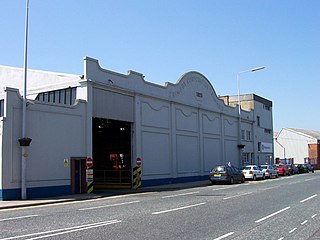
The Great Grimsby Street Tramways Company was a tramway serving Grimsby and Cleethorpes in Lincolnshire, England. It was a subsidiary of The Provincial Tramways Company. They opened a horse tramway in 1881, running from the Wheatsheaf Inn in Bargate to the border with Cleethorpes, with a branch along Freeman Street, and extended the line into Cleethorpes in 1887. It followed the trend of many British systems, and was converted to an electric tramway in December 1901. Small extensions were made to the system at both ends, but the basic plan of the system remained the same throughout its life.

Shenyang Modern Tram is a tram network operating in Hunnan New District in southern Shenyang, Liaoning province, People's Republic of China. The tram system mostly uses a traditional overhead line system, but some sections are wireless with the tram running partly on super-capacitor batteries charging at every stop, the first such system in Asia. It is the longest tram system in China.
Fan Qing was an early figure in the Chinese Communist Party, and a spy for the Kenpeitai.
Ma Shouyu was a political figure in the early Chinese Communist Party.
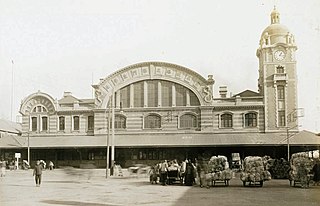
Peking–Mukden Railway was a 19th-century steam powered trunkline connecting Peking (Beijing) and Mukden through Tianjin, northeastern Hebei, and southwestern Liaoning; it was a crucial railway in North China and Northeast China.
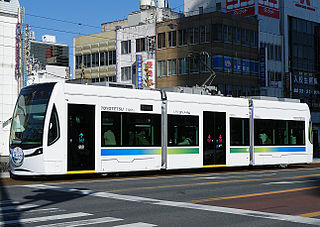
The Azumada Main Line is a tram line in Toyohashi, Aichi Prefecture, Japan operated by Toyohashi Railroad. It connects Ekimae to Akaiwaguchi and Ihara to Undoukoen-mae. The line is also referred to as the Toyotetsu Shinai-sen. Until 1976, the company also operated another tram line, the Yagyu-bashi Branch Line.
The Shenyang trolleybus electrocution accident is an overhead power line electrocution accident involving public transport in Shenyang, the capital city of Liaoning province, Northeast China. The accident happened at 15:50 on August 12, 1998, when a trolley pole on a trolleybus stopping at a bus stop in the central Shenhe District slipped off the trolley wires and contacted an uninsulated 11kV high-voltage cable. The vehicle then became electrically charged and electric discharge happened whenever passengers stepped off, resulting in 5 deaths and 9 injuries. This accident had a devastating consequence to the trolleybus operations in Shenyang, ultimately resulting in the complete removal of the city's long-running trolleybus network.












